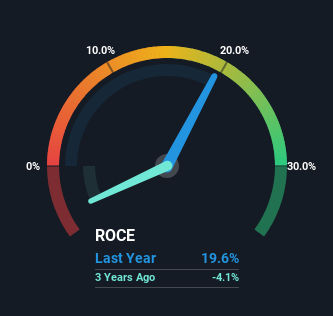- Australia
- /
- Oil and Gas
- /
- ASX:BRK
Returns on Capital Paint A Bright Future For Brookside Energy (ASX:BRK)

There are a few key trends to look for if we want to identify the next multi-bagger. Firstly, we'll want to see a proven return on capital employed (ROCE) that is increasing, and secondly, an expanding base of capital employed. Basically this means that a company has profitable initiatives that it can continue to reinvest in, which is a trait of a compounding machine. And in light of that, the trends we're seeing at Brookside Energy's (ASX:BRK) look very promising so lets take a look.
Understanding Return On Capital Employed (ROCE)
Just to clarify if you're unsure, ROCE is a metric for evaluating how much pre-tax income (in percentage terms) a company earns on the capital invested in its business. The formula for this calculation on Brookside Energy is:
Return on Capital Employed = Earnings Before Interest and Tax (EBIT) ÷ (Total Assets - Current Liabilities)
0.20 = AU$15m ÷ (AU$90m - AU$13m) (Based on the trailing twelve months to June 2023).
So, Brookside Energy has an ROCE of 20%. In absolute terms that's a great return and it's even better than the Oil and Gas industry average of 16%.
Check out our latest analysis for Brookside Energy

Historical performance is a great place to start when researching a stock so above you can see the gauge for Brookside Energy's ROCE against it's prior returns. If you'd like to look at how Brookside Energy has performed in the past in other metrics, you can view this free graph of past earnings, revenue and cash flow.
How Are Returns Trending?
We're delighted to see that Brookside Energy is reaping rewards from its investments and is now generating some pre-tax profits. About five years ago the company was generating losses but things have turned around because it's now earning 20% on its capital. Not only that, but the company is utilizing 565% more capital than before, but that's to be expected from a company trying to break into profitability. This can indicate that there's plenty of opportunities to invest capital internally and at ever higher rates, both common traits of a multi-bagger.
On a side note, we noticed that the improvement in ROCE appears to be partly fueled by an increase in current liabilities. Effectively this means that suppliers or short-term creditors are now funding 15% of the business, which is more than it was five years ago. Keep an eye out for future increases because when the ratio of current liabilities to total assets gets particularly high, this can introduce some new risks for the business.
What We Can Learn From Brookside Energy's ROCE
Long story short, we're delighted to see that Brookside Energy's reinvestment activities have paid off and the company is now profitable.
If you want to know some of the risks facing Brookside Energy we've found 2 warning signs (1 is significant!) that you should be aware of before investing here.
High returns are a key ingredient to strong performance, so check out our free list ofstocks earning high returns on equity with solid balance sheets.
Valuation is complex, but we're here to simplify it.
Discover if Brookside Energy might be undervalued or overvalued with our detailed analysis, featuring fair value estimates, potential risks, dividends, insider trades, and its financial condition.
Access Free AnalysisHave feedback on this article? Concerned about the content? Get in touch with us directly. Alternatively, email editorial-team (at) simplywallst.com.
This article by Simply Wall St is general in nature. We provide commentary based on historical data and analyst forecasts only using an unbiased methodology and our articles are not intended to be financial advice. It does not constitute a recommendation to buy or sell any stock, and does not take account of your objectives, or your financial situation. We aim to bring you long-term focused analysis driven by fundamental data. Note that our analysis may not factor in the latest price-sensitive company announcements or qualitative material. Simply Wall St has no position in any stocks mentioned.
About ASX:BRK
Brookside Energy
Engages in the exploration, production, and appraisal of oil and gas projects in the United States.
High growth potential with excellent balance sheet.
Similar Companies
Market Insights
Community Narratives



